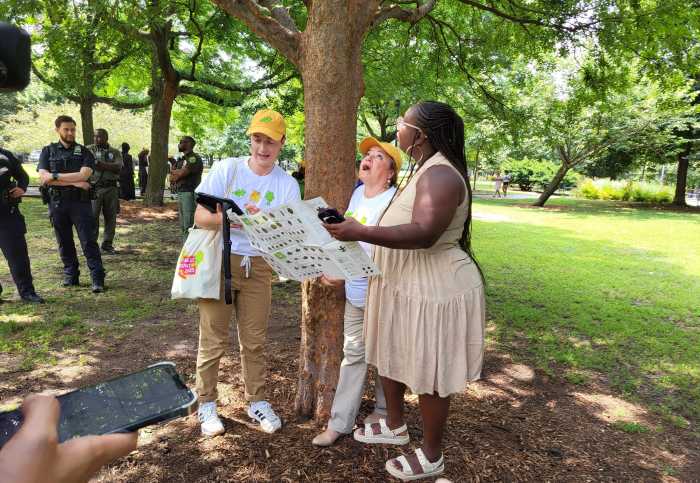
BY GARY SHAPIRO | “For Roberta, preservation is not a singular enterprise,” said Stephen Goldsmith.
A professor at the University of Utah, Goldsmith had come to praise Roberta Brandes Gratz, a pioneering scholar and preservationist who was born and raised in the Village. For Gratz, he said, preservation is part of a larger picture that is just one expression of the interconnected ways that make up cities.
Goldsmith offered these remarks at the recent Landmarks Lion Award dinner held by the Historic Districts Council that brought together donors, preservationists, scholars, and civic leaders. H.D.C., an organization located at 232 E. 11 St., guides and assists historic neighborhoods in the city.
The event took place during the lull between Superstorm Sandy and the nor’easter blizzard.
Gratz’s books include “The Battle For Gotham: New York in the Shadow of Robert Moses and Jane Jacobs” and “The Living City: Thinking Small in a Big Way.”
She started out as a reporter at the New York Post, where she covered urban issues. She formerly headed the Public Policy Committee of the Preservation League of New York State and served on the New York City Landmarks Preservation Commission.
Many examples of Gratz’s leadership were highlighted that evening, but one that stood out was her skill and determination in saving the Eldridge Street Synagogue on the Lower East Side.
“I’m so proud to have been her sous-chef,” said Richard Rabinowitz, a historian and Eldridge Street Synagogue board member, who worked with Gratz on this project.
Evident that evening was Gratz’s preservation and planning experience at the national level. Goldsmith described how Gratz accompanied students from Purchase College to New Orleans in the wake of Hurricane Katrina.
“Sleeping on a cot,” Goldsmith said, “in a tent with 300 other people for seven days, showering in a converted semitrailer, and eating in a mess hall, she explored the destruction of buildings and people’s lives and their economies, and helped students make sense — as best as anyone can — about the ways that cities can regenerate.”
Her fourth book will be on the aftermath of Katrina.
Goldsmith, who was Salt Lake City’s director of planning during the 2002 Olympics, described how Gratz’s scholarly work in New Orleans has a bearing on contemporary events.
“Her research there may even offer clues on how her favorite place in the world, New York City, might be able to restore the lives and places of many who are so terribly affected by Hurricane Sandy,” he noted.
Gratz then took to the podium to thank those who had spoken in honor of her earlier in the evening. One of these was Ron Shiffman of the Pratt Institute Center for Community and Environmental Development, who was formerly a City Planning commissioner, appointed by Mayor David Dinkins, from 1990 to 1996.
“Ron and I have a longstanding argument for 40 years over who taught whom what,” she said. “Well, tonight I have the last word.”
Gratz recalled how Shiffman took her from Kelly St.’s Banana Kelly movement in the South Bronx in the 1970s to Gregory O’Connell’s pier redevelopment project in Red Hook in the 1980s “to see positive community change led by innovative and dedicated individuals.”
Referring to parochialism exhibited by a touted cosmopolitan borough, Gratz said this was still a time “when most architecture, planning and preservation organizations did not know that Manhattan had bridges.”
Turning next to historian Richard Rabinowitz, Gratz said he taught her “how rich is the story that accompanies a landmark, and that a landmark is shallow without mining that story.”
She said she could not have led the restoration of Eldridge Street Synagogue without him.
About Stephen Goldsmith, she said he was “the first and probably the only artist to head a planning commission without a planning degree.”
She described taking Goldsmith to meet Jane Jacobs a couple years before her death.
“He helped make happen the creation of the Center for the Living City that Jacobs and I had been discussing” for a half decade before, she said of Goldsmith.
In her remarks, Gratz challenged views prevalent in the real estate industry.
“Preservation has made them rich,” she said of developers. “Not only are many of them making fortunes today — restoring and repurposing the buildings that we wouldn’t let them tear down — but they are also making fortunes on building in or near the historic districts whose designation they probably opposed.
“In New York and every city that I know of, pre-World War II neighborhoods exhibit the highest real estate values of their city,” she noted. “Landmarks add value to a place. Designation simply restrains excess, promises respect for context, and ensures design in keeping with the historic fabric.”
Others that evening echoed her chiding of the real estate industry, among them Simeon Bankoff, executive director of the Historic Districts Council.
“There is the myth that preservation gets in the way of development, when in fact the reverse is more often true,” he stated.
H.D.C. President Françoise Bollack made the point that 3 percent is not an interest rate, but the percentage of properties in New York’s all five boroughs that are protected by landmark designation.
Among friends and family seated at Gratz’s table with her at the H.D.C. dinner was one of Canada’s leading architects, Eb Zeidler, for whom Jane Jacobs’s husband had worked.
Also attending the event was architect Belmont Freeman, who is taking a small group to Cuba this month in coordination with the Storefront for Art and Architecture.
“People think that in Cuba, everything stopped in 1959 at the time of the revolution,” he said. “But in fact through the 1960s there was incredible avant-garde architecture.”
Seated nearby was Arete Warren, the former chairperson of the Preservation League of New York State, who described her concern over the impact of hydrofracking on the cultural and historic landscape Upstate. Warren is co-author of “Glass Houses: A History of Greenhouses, Orangeries and Conservatories.”
Barry Lewis of “A Walk Around Brooklyn” was on hand, and expressed hope about securing funding for a documentary on Alice Austen, the noted photographer who resided on Staten Island. Never seeing her work as a job but as an art, she would carry about 30 pounds of equipment to Manhattan to photograph immigrants.
“Austen caught the pride that they had,” Lewis said of Austen, contrasting her with Jacob Riis, “whose photos show immigrants looking miserable.”
Also on hand was Laurie Beckelman, a former Landmarks Preservation Commission chairperson, who is a principal of Beckelman+Capalino, a firm advising cultural and nonprofit organizations. She told this newspaper, “Historic districts keep giving value to the city.”
In September, Beckelman told an amusing anecdote at an Uptown dinner hosted by the Friends of the Upper East Side Historic Districts, which honored Frederic S. Papert, the longtime advertising executive and civic leader, who helped restore 42nd St.
Beckelman once participated with the Municipal Art Society on plans to publicly honor Papert and Brendan Gill, the man about town and New Yorker writer. She obtained a permit to install a metal plaque in the middle of 42nd St. and Fifth Ave., and there was a ceremony to commemorate it.
“Little did we know that the Department of Transportation was going to pave the road the next day,” she said.
To return to the Historic Districts Council dinner, an amusing moment occurred when Bankoff offered kudos for everyone in the room connected with the organization “who is a director or adviser — or think they are.”
Author Robert Caro of “The Power Broker” fame, attending a New York Landmarks Conservancy dinner later in the week, said Gratz “has a rare understanding of the importance to the city of the spirit of community.”
Prior recipients of the Landmarks Lion awards who were present at the recent H.D.C. event were Reverend Dr. Thomas F. Pike, Robert Silman, Barry Lewis, Anthony C. Wood, Kent Barwick, Joan K. Davidson, Jack Taylor, Christabel Gough, Robert Silman, Walter Melvin, Lisa Ackerman and Otis Pearsall.
Andrew S. Dolkart and Anthony Wood, who both teach at Columbia, were also on hand — Wood being another previous Landmarks Lion winner.
Wood, who is founder of the New York Preservation Archive Project, said, “It’s ironic that a movement that runs around saving the monuments of everyone else is so unaware of the need to document its own history.”
When the preservation movement does fully document its history, Roberta Brandes Gratz will be among those rightfully included.




































